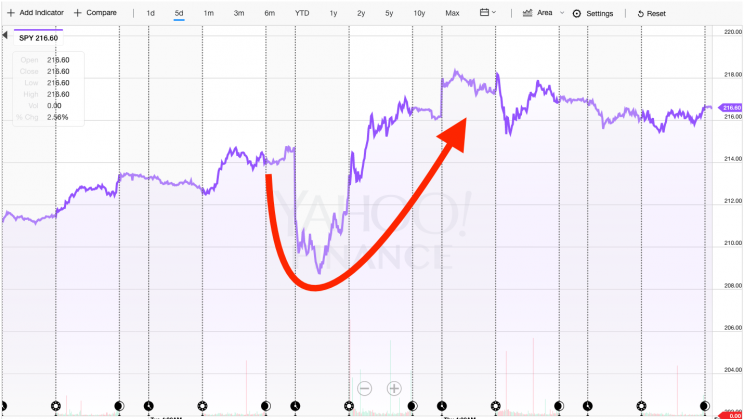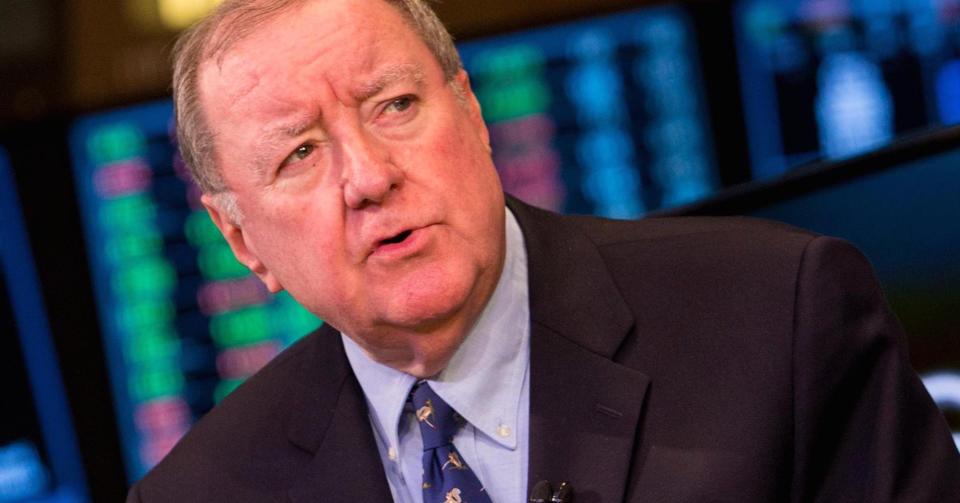WEEK AHEAD: American retail in focus
Election week has come and gone. Donald Trump has been elected president of the United States.
Markets hated the news, and then loved it.
But now we turn the page and return to regularly-scheduled programming: corporate earnings, economic data, and plenty of Fedspeak.
The upcoming week will be highlighted by earnings reports from major retailers including Best Buy (BBY), Walmart (WMT), and Target (TGT). In economic data, we’ll get the monthly report on retail sales as well as a reading on inflation.
Markets — particularly the Treasury market — will also still be working through the implications of a Trump administration.
Up, Up, Down, Up, Up, Flat
It was a hectic week that, when all was said and done, saw US stocks have their biggest rally of the year while US Treasuries had their biggest drop in years.
And when you include the frantic overnight trading session on Tuesday night and the wee hours of Wednesday morning, it feels like we all sort of worked a six-day week in the span of five.
When the dust settled, the Dow closed at a record high of 18,847.66. The S&P 500 closed up more than 3% at 2,164.45, just about 30 points away from a record. The tech-heavy Nasdaq didn’t have quite as positive of a week, but was still higher, gaining about 2% to close at 5,237.11.

Treasury yields, after rallying during classic “risk off” trading action on Tuesday night, eventually sold off, rising to their highest levels in almost a year. Markets here were reacting to the potential of additional supply from a big Trump infrastructure package as well as responding to potential higher rates of growth and inflation.
The University of Michigan’s latest consumer confidence survey published Friday, while not including any impacts from the election, showed inflation expectations from consumers on the rise.
In a roundabout way, it seems the higher yields and hopes for faster growth the Federal Reserve has been seeking to put in place over the last several years came together all at once this week.
Economic calendar
Monday: No major economic reports.
Tuesday: Import price index (+0.4% expected; +0.1% previously); Empire Manufacturing (-2 expected; -6.8 previously); Retail sales, October (+0.6% expected; +0.6% previously)
Wednesday: Producer prices (+0.3% expected; +0.3% previously); Industrial production (+0.2% expected; +0.1% previously); NAHB housing market index (63 expected; 63 previously)
Thursday: Housing starts (+10.3% expected; -9% previously); Building permits (-2.9% expected; +6.3% previously); Consumer price index (+0.4% expected; +0.3% previously); “Core” consumer prices, year-on-year (+2.2% expected; +2.2% previously)
Friday: Leading economic index (+0.1% expected; +0.2% previously)
Unintended consequences
We wrote ahead of the election that the only thing Donald Trump and Hillary Clinton agreed on — more infrastructure spending — was probably not the best idea for the US economy.
And here we are: markets are bracing for what could be a $1 trillion spending package.
The reasoning pre-election behind why the US economy doesn’t need a big spending package now is that with wages on the rise and the economy near full-employment, a major fiscal package could potentially overwhelm an economy starved for workers.

This is an idea Bloomberg View columnist Conor Sen wrote about back in June, and for me this was and remains the clearest analysis of where the US economy could be headed next.
“If we had to find 500,000 construction workers tomorrow, from a math standpoint it would be impossible. The slack isn’t there,” Sen wrote. The upshot, is that housing will draw workers away from mining, agriculture, and manufacturing.
But in the aggregate, this pool of manual laborers, ex-immigration, could work in any of these fields. If pulling from mining into housing causes wage inflation and stresses this pool of workers, then pulling from housing into building highways does the same.
A report out Friday from Reuters gave a a slightly different, but still important, overview of how the state of the labor market isn’t the only thing standing in the way of a Trump spending package: lower taxes are also a problem.
Municipal bonds, which would likely play a major role in the construction of any spending package, are tax exempt. This makes them attractive to investors who are willing to a premium for this debt — which brings down servicing costs to municipalities issuing the debt. A classic case of financial engineering making everyone happy.
But Trump’s tax plan calls for top-bracket tax rates to fall to 33% from 39%. High-net-worth individuals, who use municipal bonds as a tax-advantaged way to get a safer fixed-income asset into their portfolio, could now be disincentivized from buying this debt given that their new lower tax rate impairs these advantages.
In turn, muni investors will likely demand higher coupons.
For the cities and towns issuing this debt, it becomes more expensive to fund infrastructure projects. And given that most infrastructure funding happens at the state and local level — with federal funds disbursed contingent on local government funding — suddenly a huge spending package seems less like a no-brainer.
Why did stocks do what they did this week?
Reporting on the stock market is a funny thing.
There is the price level of overall indexes and the price of certain securities, each of which are easily ascertained online. If stocks went up, you can write that stocks went up. Same for an individual stock. The inverse also applies.
But things get fuzzy when you try to write about why stocks (or a stock) did or did not go up.

This past week was perhaps the best week for being a markets reporter that I can remember. Stocks went up on Monday and Tuesday as FBI director James Comey’s weekend letter that he would re-open an investigation into Hillary Clinton’s emails was seen tipping the scales in Clinton’s favor.
Then Tuesday night came and Donald Trump appeared in position to win the election and markets panicked. Dow futures, at one point, were down about 800 points near midnight on Tuesday.
And then stocks came all the way back because markets decided, “No, wait, Trump won the White House and Republicans control both houses of Congress and this is good!”
Each of these moves were equal parts explicable and inexplicable.
For the average investor using the stock market as a wealth-creation tool for retirement, this week’s lesson was the oldest one in the book: stay invested, don’t panic, don’t try to time the market.
For traders, the lesson is one trading floor legend Art Cashin reiterates almost daily, “Stay alert, and remain very, very nimble.”

…For stock market reporters…
For stock market reporters I’m not sure there are any clear takeaways.
Some will want to make fun, for example, of The Wall Street Journal’s Tuesday headline that attributed a stock market rally to the Comey news and an increased likelihood of a Clinton win. That is fine, and in hindsight it looks silly, but if markets decide that this is what moved the market, well, then, that’s it!
And I think a lot of this, really, comes down to something people in and around markets — also: me — do a lot, which is talk about the market like it’s a real thing.
It’s not! The market does not have agency but does reflect the choices made by market participants who do have agency. In turn, the market appears to make its own decisions when it really reflects the decisions made by those participating. It is when “the market” doesn’t do you what you want that you say, “The market did some thing and I don’t like it.”
In his morning newsletter on Friday, Bloomberg’s Joe Weisenthal wrote that in markets, price moves before the narrative.
“For example, when markets briefly crashed after Trump’s win, there was a narrative about populism and uncertainty. When they rebounded and surged, the narrative switched to being about deregulation and reflation. The point is that nobody really knows.”
This is right. But it also doesn’t mean that trying to explain the price is a necessarily fraught — read: wrong, stupid, lazy, bad — exercise. It’s just that your explanation of the price is ex-post.
Successful investing in the market requires you get ahead of price movements. Successful writing about the markets requires that you explore why prices moved.
Back in August 2015, I wrote about the particularly chaotic and nonsensical action we saw at that time which was attributed, in part, to “concerns over global growth.” This didn’t make much sense, but neither did admitting you didn’t know anything. There was, after all, something to react to (price!) even if why the price happened the way it did wasn’t particularly straightforward.
As I wrote: “But if the last decade or so of financial commentary has really been about cutting down the BS, then we’re certainly at a point where the admission of not knowing is amount to some other, mutilated form of BS.
“If the post-[efficient market hypothesis] era has been about cutting down the value of year-end price targets, of exposing the idea that a headline on a slow Tuesday in April that reads, ‘Stocks Gyrate On Fears Over Global Growth’ is probably just something someone very nearly made up, then a bastardized version of the same is happening in the other direction.”
No one knows, I guess, because there is nothing to know.
The truth markets respond to is only true because markets respond to it.
But I’m not sure that if that means it’s true.
—
Myles Udland is a writer at Yahoo Finance.
Read more from Myles here; follow him on Twitter @MylesUdland

 Yahoo Finance
Yahoo Finance 
